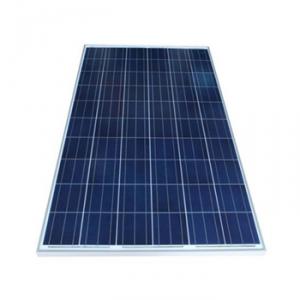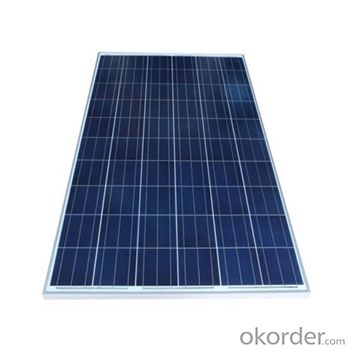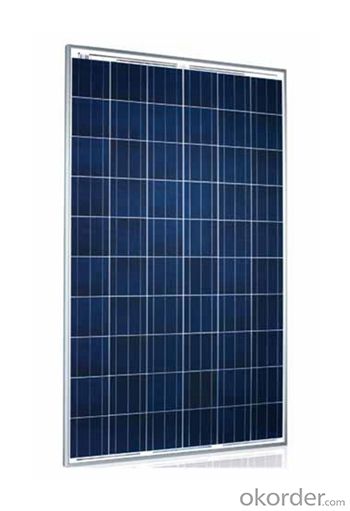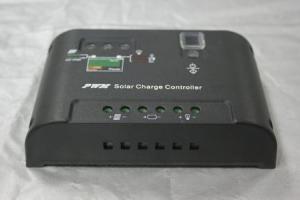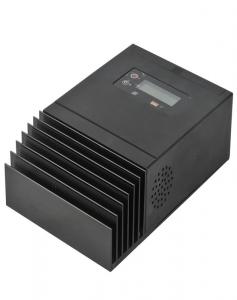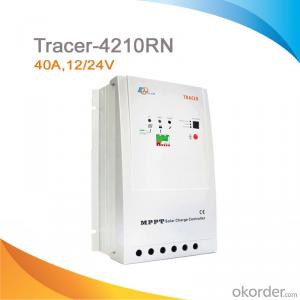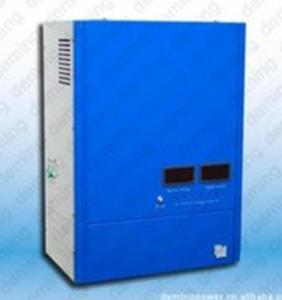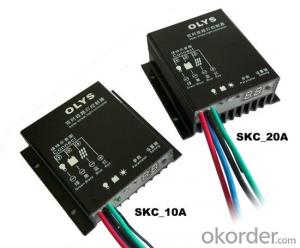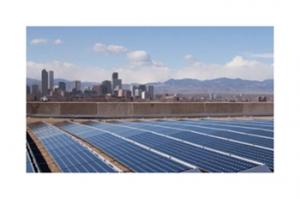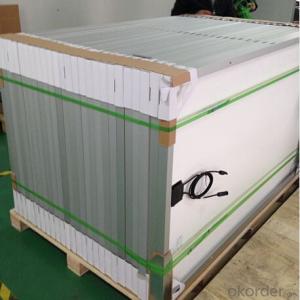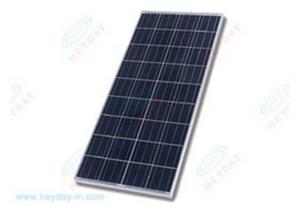Solar Panel Controllers for Sale - Solar Modules Poly-Crystalline 250W 156*156 Module
OKorder Service Pledge
OKorder Financial Service
You Might Also Like
Solar Module Descriptions:
Solar Power Modules (known as Photovoltaics - PV) can generate electricity for your home or business, either as part of a stand-alone solar power system, or for buildings already connected to the local electricity network.
PV systems use the most abundant energy source on the planet, solar radiation, to generate electricity. They are silent, consume no fuel and generate no pollution. They also contribute to the reduction of greenhouse gas emissions; a 2kW PV system on a house will prevent the emission of about 40 tonnes of CO2 during its projected 30 year lifetime. Furthermore, the use of PV will reduce your electricity bills and exposure to fluctuating and steadily rising electricity prices.
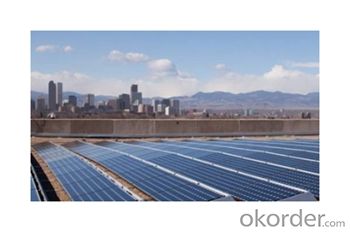
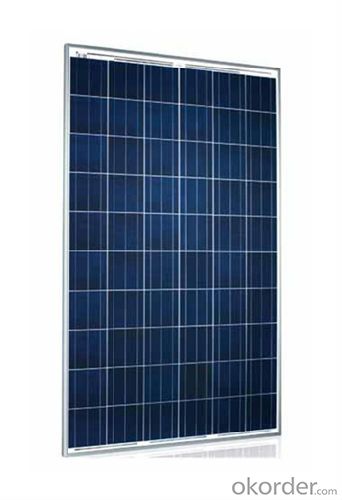
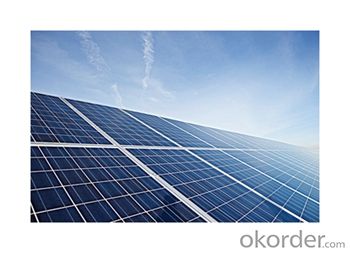
Electrical Characteristics
Max-power (W) | 245 |
Max-Power Voltage (V) | 30.40 |
Max-Power Current (A) | 8.06 |
Open-Circuit Voltage (V) | 37.50 |
Short-Circuit Current (A) | 8.66 |
Mechanical Characteristics
Cable type, Diameter and Length | 4mm2, TUV certified, 1000mm |
Type of Connector | Compatible with MC4 plug |
Arrangement of cells | 6*10 |
Cell Size | 156*156 |
Dimension | 1580*1069*45 |
Weight | 19.5Kg |
Glass, Type and Thickness | High Transmission, Low Iron, Tempered Glass 3.2mm |
Features
Guaranteed positive tolerance 0/+5w ensures power output reliability
Strong aluminum frames module can bear snow loads up to 5400Pa and wind loads up to 2400Pa.
Excellent performance under low light environments (mornings evenings and cloudy days)
12 years for product defects in materials and workmanship and 25 years for 80% of warranted minimum power.
Certifications and standards: IEC 61215.
Manufactured according to International Quality and Environment Management System (ISO9001, ISO14100).
FAQ
Q: What kind of loads can I run on PV?
With a correctly designed PV system you can power almost any electrical load. However, as the load size increases the expense also increases. Loads like hot water heaters, air conditioners, room heaters and electric stoves should be avoided. The added cost of trying to power loads like these is very cost prohibitive. If these loads have to be powered it will be a lot less expensive to change the appliance to use an alternative fuel type like propane.
Q: When do I need a charge controller and why?
The safest way to figure out if you need a charge controller is to take Battery Amp Hour Capacity and divide this by the Solar Panel max. power amp rating. If the quotient is above 200, you don't need a controller. If the number is less than 200 than you need a controller.
For example if you have a 100 amp hour battery and a 10 watt panel, you take 100 and divide it by .6 (600mA) and you get 166.6. Since this is less than 200 you need a charge controller. If you have a five-watt panel in the above example you take 100 divided by .3 (300mA) and you come up with 333.3. Since this is larger than 200 you do not need a charge controller. However you still need a blocking diode, to prevent the battery from discharging to the panel at night. So as a general rule of thumb you don't need a charge controller unless you have more than five watts of solar for every 100-amp hours of battery capacity.
Q: What is PV & how does it work?
PV stands for photovoltaic. Photo = Light and Voltaic = Electricity. A solar cell converts light to electricity.
A solar cell is made of silicon. Computer chips are made of this same material. Basically, when light strikes the surface of a solar cell some of it is absorbed into the silicon. This light energy bumps the electrons loose and causes energy to flow.
By packaging approximately 36 solar cells together a solar panel or a solar module is created. When you have more then one solar panels you create a solar array.
- Q: How do you protect a solar controller from extreme weather conditions?
- To protect a solar controller from extreme weather conditions, it is recommended to install it in an enclosure or protective case that is waterproof, dustproof, and resistant to temperature fluctuations. Additionally, proper insulation and sealing of all cable connections can help prevent any damage from moisture or debris. Regular maintenance and inspection are also essential to ensure the controller's functionality and to address any potential issues promptly.
- Q: What is the role of a solar controller in preventing battery self-discharge?
- The role of a solar controller in preventing battery self-discharge is to regulate and control the flow of solar energy to the battery. It ensures that the battery is not overcharged or drained excessively, which helps in minimizing self-discharge and prolonging the battery's lifespan.
- Q: How does a solar controller handle shading or partial shading of solar panels?
- A solar controller handles shading or partial shading of solar panels by utilizing a technique called Maximum Power Point Tracking (MPPT). MPPT technology allows the controller to constantly monitor the voltage and current output of the solar panels and adjust the operating parameters to ensure they are always operating at their maximum power output, even when shaded. This helps to optimize the overall performance of the solar system and mitigate the impact of shading on energy generation.
- Q: How does a solar controller handle load control for powering other devices?
- A solar controller manages load control by regulating the flow of electricity from the solar panels to power other devices. It ensures that the power generated by the panels is distributed efficiently and effectively to meet the energy demands of the connected devices, while also protecting the battery bank from overcharging or discharging. The controller monitors the battery voltage and adjusts the charge/discharge cycle accordingly, ensuring optimal utilization of the available solar energy while preventing any damage to the system.
- Q: How does a solar controller handle battery equalization?
- A solar controller manages battery equalization by periodically applying a higher voltage to the battery bank, typically during a specific charging cycle. This process helps to balance the charge levels across individual batteries within the bank, preventing overcharging or undercharging of any specific battery. By equalizing the battery charge, the solar controller improves the overall performance and longevity of the battery bank.
- Q: How does a solar controller prevent damage from lightning-induced surges?
- A solar controller prevents damage from lightning-induced surges by incorporating surge protection devices such as varistors or transient voltage suppressors. These devices are designed to divert excessive voltage caused by lightning strikes away from sensitive electronic components, ensuring the safety and integrity of the solar system.
- Q: Can a solar controller be used with solar-powered indoor hospitality facilities?
- Solar-powered indoor hospitality facilities can utilize a solar controller. This device is vital for regulating the flow of electricity from the solar panels to the batteries in a solar power system. In the context of solar-powered indoor hospitality facilities, the solar controller would have a significant role in managing the energy generated by the solar panels. Its main function would be to ensure efficient storage of this energy in batteries for use during periods without sunlight, such as nighttime or cloudy days. By employing a solar controller, indoor hospitality facilities can effectively harness solar power as a sustainable and renewable energy source to power their operations.
- Q: Can a solar controller be used in a solar-powered airship?
- Yes, a solar controller can be used in a solar-powered airship. A solar controller is responsible for regulating the power flow from the solar panels to the battery or system being powered. In a solar-powered airship, the solar controller would play a crucial role in managing the charging and discharging of the battery, ensuring efficient use of solar energy and optimizing the airship's performance.
- Q: How long is the lifespan of a typical solar controller?
- The lifespan of a typical solar controller can vary due to various factors. On an average note, a well-maintained and high-quality solar controller can endure for approximately 10 to 15 years. However, there have been instances where solar controllers have surpassed this timeframe, reaching nearly 20 years or even more. Several factors can impact the durability of a solar controller, such as the brand and quality of the controller, the conditions it operates under, and the level of maintenance and care it receives. Controllers of superior quality from reputable brands generally exhibit better construction and sturdiness, resulting in an extended lifespan. The conditions under which the solar controller operates also greatly influence its longevity. Extreme temperatures, humidity, and exposure to harsh weather conditions can have a detrimental effect on the controller's lifespan. Conversely, controllers installed in regions with milder climates and protected locations tend to have a longer lifespan. Proper maintenance and care play a crucial role in prolonging the lifespan of a solar controller. Regular inspections and cleanings, ensuring adequate ventilation, and safeguarding the controller against excessive moisture or dust can significantly contribute to its overall lifespan. It is equally important to adhere to the manufacturer's maintenance guidelines and avoid overloading the controller beyond its rated capacity. In conclusion, although the average lifespan of a solar controller is typically around 10 to 15 years, various factors can influence its longevity. By investing in a high-quality controller, providing suitable operating conditions, and practicing regular maintenance, it is possible to extend the lifespan and optimize the efficiency of a solar controller.
- Q: How does a solar controller prevent damage from over-discharging of batteries?
- A solar controller prevents damage from over-discharging of batteries by constantly monitoring the battery voltage and disconnecting the load when it drops below a certain threshold. This prevents the batteries from being drained beyond their safe capacity, which can lead to irreversible damage and reduced lifespan.
Send your message to us
Solar Panel Controllers for Sale - Solar Modules Poly-Crystalline 250W 156*156 Module
OKorder Service Pledge
OKorder Financial Service
Similar products
Hot products
Hot Searches
Related keywords
